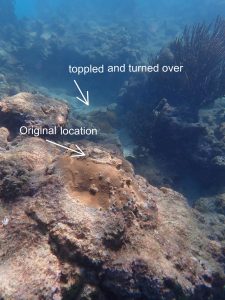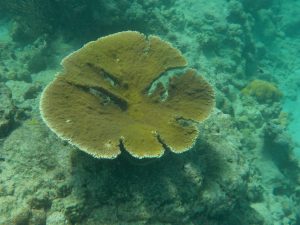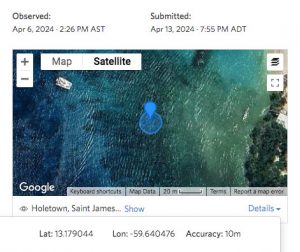Click on images for larger versions
More photos are available on the iNaturalist posts.
For 3 specimens – V1, V2 and V5 – I have photos in both 2023 and early 2024; V1 exhibited about 75% dieback in the interval, V2 and V5, 100%. Dieback is attributed to one or more extreme warming/coral bleaching events in 2023.
For 6 specimens NOT observed in both 2023 and 2024:
V3: Feb 6, 2020 – toppled and turned over; all still living
V4: Mar 3, 2019, all living
V6: Mar 7, 2019, all living
V7: Mar 23, 2015, all living
V8: Mar 10, 2024, appears unaffected by coral bleaching in 2023
V9: Apr 6, 2024, entirely dead
Specimen V1
Lat: 13.179726 Lon: -59.640668
Mar 23, 2015; on iNat in 2015:/19973670
Jan 11, 2023: iNat Observation 199689188
Feb 4, 2024 iNat Observation 199690758
 |
Specimen V2
Lat: 13.179726 Lon: -59.640668
Jan 11, 2023 iNat Observation 199689414
Feb 4, 2024 iNat Observation 199691175

Photo on Jan 11, 2023 showing proximity of specimens V1 and V2. Specimen v1 in foreground, arrow points to Specimen V2, a few meters towards shore from V1; V2 about 1/4 size of V1.
Specimen V3
Lat: 13.179479 Lon: -59.64055
Feb 6, 2020
iNat 38391855
 |
Specimen V4
Lat: 13.179479 Lon: -59.64055
Mar 3, 2019
iNat 21068780
 |
Specimen V5
Lat: 13.179182 Lon: -59.640723
Mar 7, 2019
iNat 21024761
 |
 Apr 4, 2023 View iNaturalist Record 199606743 |
 Feb 16, 2024. The colony is entirely dead View iNaturalist Record 199606743 |
Specimen V6
Lat: 13.179182Lon: -59.640723
Mar 7, 2019
iNat 1024597
 |
Specimen V7
Lat: 13.179157Lon: -59.640704
Mar 23, 2015
https://www.inaturalist.org/observations/19973671
 |
Specimen V8
Mar 10, 2024, appears unaffected by coral bleaching in 2023
https://www.inaturalist.org/observations/202039954
Specimen V9
Apr 6, 2024
Lat: 13.179043 Lon: -59.640476. 10 m
https://www.inaturalist.org/observations/207058996














